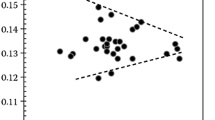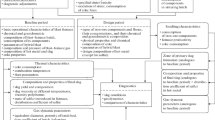Abstract
The paper presents a balance model of the blast-furnace process improved by the researchers from the Ural Federal University and Magnitogorsk Iron and Steel Works. It generally represents a system of deterministic dependencies characterizing the thermal, reduction, gas dynamics, blast, and slag modes of blast-furnace melting. The basic principle underlying the model is full-scale mathematical modeling. Indicators characterizing the process of the final slag for implementation of the normal slag mode of blast-furnace melting (the slag viscosity at temperatures ranging from 1350 to 1550°C, as well as the values of slag viscosity gradients) were proposed. The slag viscosity gradient along with the acceptable ranges of slag viscosity at different slag temperatures are used in modeling the slag mode as the limiting factors for the diagnosis of slag mode. Selection of the limit values of each of the ranges and the viscosity gradient is carried out by the expert evaluation method. The structure of the model for calculating the parameters of the final slag is considered. Using a mathematical model of the blast-furnace process, the analysis of the slag mode of blast-furnace melting was performed according to the actual indicators of their operation. It was established that desulfurizing ability of the slag is insufficiently used; as a result, the smelted cast iron has a down-graded quality in terms of both the sulfur and silicon content. Due to the changes in the slag mode characteristics, other conditions being equal, it is possible to get a positive effect on the gas permeability in the slag formation zone; the gas reducing ability and productivity of the blast furnace increase; the coke consumption decreases. The authors present the results of design calculations of the performance indicators of the furnaces of the Magnitogorsk Iron and Steel Works when changing the composition of loaded materials. Recommendations on the slag optimal basicity are given. Calculations showed that the optimal values of basicity of the final slag, which ensure its maximum liquid mobility, for the operating conditions of blast furnaces of the Magnitogorsk Iron and Steel Works are 1.04–1.05 for the CaO/SiO2 ratio and 1.30–1.32 for the (CaO + MgO)/SiO2 ratio.


Similar content being viewed by others
REFERENCES
Pavlov, A.V., Polinov, A.A., Spirin, N., Onorin, O.P., and Lavrov, V.V., Use of model systems for solving new technological problems in blast-furnace production, Metallurgist, 2017, vol. 61, nos. 5–6, pp. 448–454. https://doi.org/10.1007/s11015-017-0516-7
Onorin, O.P., Spirin, N.A., Terent’ev, V.L., Gileva, L.Yu., Rybolovlev, V.Yu., Kosachenko, I.E., Lavrov, V.V., and Terent’ev, A.V., Komp’yuternye metody modelirovaniya domennogo protsessa (Computer Methods of Blast-Furnace Process Modeling), Spirin, N.A., Ed., Yekaterinburg: Ural. Gos. Tekh. Univ.-Ural. Politekh. Inst., 2005.
Spirin, N.A., Lavrov, V.V., Rybolovlev, V.Yu., Krasnobaev, A.V., Onorin, O.P., and Kosachenko, I.E., Model’nye sistemy podderzhki prinyatiya reshenii v ASU TP domennoi plavki. Monografiya (Model Decision Support Systems in Automatic Control Systems of Manufacturing Process of Blast Furnace Melting: Monograph). Yekaterinburg: Ural. Fed. Univ., 2011.
Spirin, N.A., Lavrov, V.V., Rybolovlev, V.Yu., Gileva, L.Yu., Krasnobaev, A.V., Shvydkii, V.S., Onorin, O.P., Shchipanov, K.A., and Burykin, A.A., Matematicheskoe modelirovanie metallurgicheskikh protsessov v ASU TP (Mathematical Modeling of Metallurgical Processes in Automatic Control Systems of Manufacturing Process), Yekaterinburg: Ural. Fed. Univ., 2014.
Bol’shakov, V.I., Tekhnologiya vysokoeffektivnoi energosberegayushchei domennoi plavki (Technology of Highly Efficient Energy-Saving Blast Furnace Melting, Kiev: Naukova Dumka, 2007.
Tovarovskii, I.G., Domennaya plavka (Blast Furnace Melting), Dnepropetrovsk: Porogi, 2009.
Gimmel’farb, A.A. and Kotov, K.I., Protsessy vosstanovleniya i shlakoobrazovaniya v domennykh pechakh (Processes of Reduction and Slag Formation in Blast Furnaces), Moscow: Metallurgiya, 1982.
Gordon, Y. and Izumskiy, N. Mathematical model and stabilization system for slag mode of blast furnace operation, Proc. AISTech-2017 Iron and Steel Technology Conf., Nashville, Tenn., 2017, vol. 1, pp. 797–805.
Jia, R., Deng, L., Yun, F., Li, H., Zhang, X., and Jia, X., Effects of SiO2/CaO ratio on viscosity, structure and mechanical properties of blast furnace slag glass ceramics, Mater. Chem. Phys., 2019, vol. 233, pp. 155–162. https://doi.org/10.1016/j.matchemphys.2019.05.065
Shen, X., Chen, M., Wang, N., and Wang, D., Viscosity property and melt structure of CaO–MgO–SiO2–Al2O3–FeO slag system, ISIJ Int., 2019, vol. 59, no. 1, pp. 9–15. https://doi.org/10.2355/isijinternational.ISIJINT-2018-479
Zheng, H., Ding, Y., Zhou, S., Wen, Q., Jiang, X., Gao, Q., and Shen, F., Viscosity prediction model for blast furnace slag with high Al2O3, Steel Res. Int., 2020, vol. 92, no. 1, p. 1900635. https://doi.org/10.1002/srin.201900635
Jiao, K., Zhang, J., Liu, Z., and Chen, C., Effect of MgO/Al2O3 ratio on viscosity of blast furnace primary slag, High Temp. Mater. Processes, 2018, vol. 38, pp. 354–361. https://doi.org/10.1515/htmp-2018-0019
Gan, L. and Lai, C., A general viscosity model for molten blast furnace slag, Metall. Mater. Trans. B, 2014, vol. 45, no. 3, pp. 875–888. https://doi.org/10.1007/s11663-013-9983-9
Iida, T., Sakai, H., Kita, Y., and Shigeno, K., An equation for accurate prediction of the viscosities of blast furnace type slags from chemical composition, ISIJ Int., 2000, vol. 40, pp. 110–114. https://doi.org/10.2355/isijinternational.40.suppl_s110
Shu, Q., A viscosity estimation model for molten slags in Al2O3–CaO–MgO–SiO2 system, Steel Res. Int., 2010, vol. 80, no. 2, pp. 107–113. https://doi.org/10.2374/SRI08SP085
Jiang, D., Zhang, J., Wang, Z., Feng, C., Jiao, K., and Xu, R., A prediction model of blast furnace slag viscosity based on principal component analysis and k-nearest neighbor regression, JOM, 2020, vol. 72, no. 11, pp. 3908–3916. https://doi.org/10.1007/s11837-020-04360-9
Pavlov, A.V., Onorin, O.P., Spirin, N.A., and Polinov, A.A., MMK blast furnace operation with a high proportion of pellets in a charge. Part 1, Metallurgist, 2016, vol. 60, nos. 5–6, pp. 581–588. https://doi.org/10.1007/s11015-016-0335-2
Schlackenatlas, Verein Deutscher Eisenhüttenleute, Verlag Stahleisen, 1981.
Voskoboinikov, V.G., Dunaev, N.E., and Mikhalevich, A.G., Svoistva zhidkikh domennykh shlakov (Properties of Liquid Blast Furnace Slags), Moscow: Metallurgiya, 1975.
Zhilo, N.L., Formirovanie i svoistva domennykh shlakov (Formation and Properties of Blast Furnace Slags), Moscow: Metallurgiya, 1974.
Author information
Authors and Affiliations
Contributions
A.V. Pavlov suggested the idea of this paper, performed the substantiation of the topic relevance, elaborated the content of the main sections, and prepared the examples of practical implementation of the modern information systems in industry.
N.A. Spirin suggested the idea of the paper, performed the substantiation of the topic relevance, prepared the concept, detailed plan, and the draft version of the paper, selected references, carried out the final editing, and preparation of the conclusions.
V.A. Beginyuk elaborated the content of the main sections, performed selection of references, and prepared the paper documents.
V.V. Lavrov elaborated the content of the main sections, prepared the examples of practical implementation of modern information systems in industry.
I.A. Gurin elaborated the content of the sections related to the development and software implementation of modern information systems in metallurgy, prepared the abstract, keywords, translation of the paper materials into English.
Corresponding authors
Ethics declarations
The authors declare that they have no conflicts of interest.
INFORMATION ABOUT THE AUTHORS
Aleksandr V. Pavlov, Cand. Sci. (Eng.), Head of the Blast-Furnace Shop of the Magnitogorsk Metallurgical Plant.
Nikolai A. Spirin, Dr. Sci. (Eng.), Prof., Head of the chair “Thermal Physics and Informatics in Metallurgy”, Ural Federal University named after the First President of Russia B.N. Eltsyn.
Vitalii A. Beginyuk, Leading Specialist of Blast-Furnace Shop, Magnitogorsk Iron and Steel Works.
Vladislav V. Lavrov, Dr. Sci. (Eng.), Prof. of the Chair “Thermal Physics and Informatics in Metallurgy”, Ural Federal University named after the First President of Russia B.N. Eltsyn.
Ivan A. Gurin, Cand. Sci. (Eng.), Assist. Prof. of the Chair “Thermal Physics and Informatics in Metallurgy”, Ural Federal University named after the First President of Russia B.N. Eltsyn.
Additional information
Translated by E. Smirnova
Supplementary Information
The online version contains supplementary material available at http://doi.org/10.17073/0368-0797-2022-6-413-420https://fermet.misis.ru/jour/article/view/2322.
About this article
Cite this article
Pavlov, A.V., Spirin, N.A., Beginyuk, V.A. et al. Analysis of the Slag Mode of Blast Furnace Melting Using Model Decision Support Systems. Steel Transl. 52, 574–580 (2022). https://doi.org/10.3103/S0967091222060110
Received:
Revised:
Accepted:
Published:
Issue Date:
DOI: https://doi.org/10.3103/S0967091222060110




